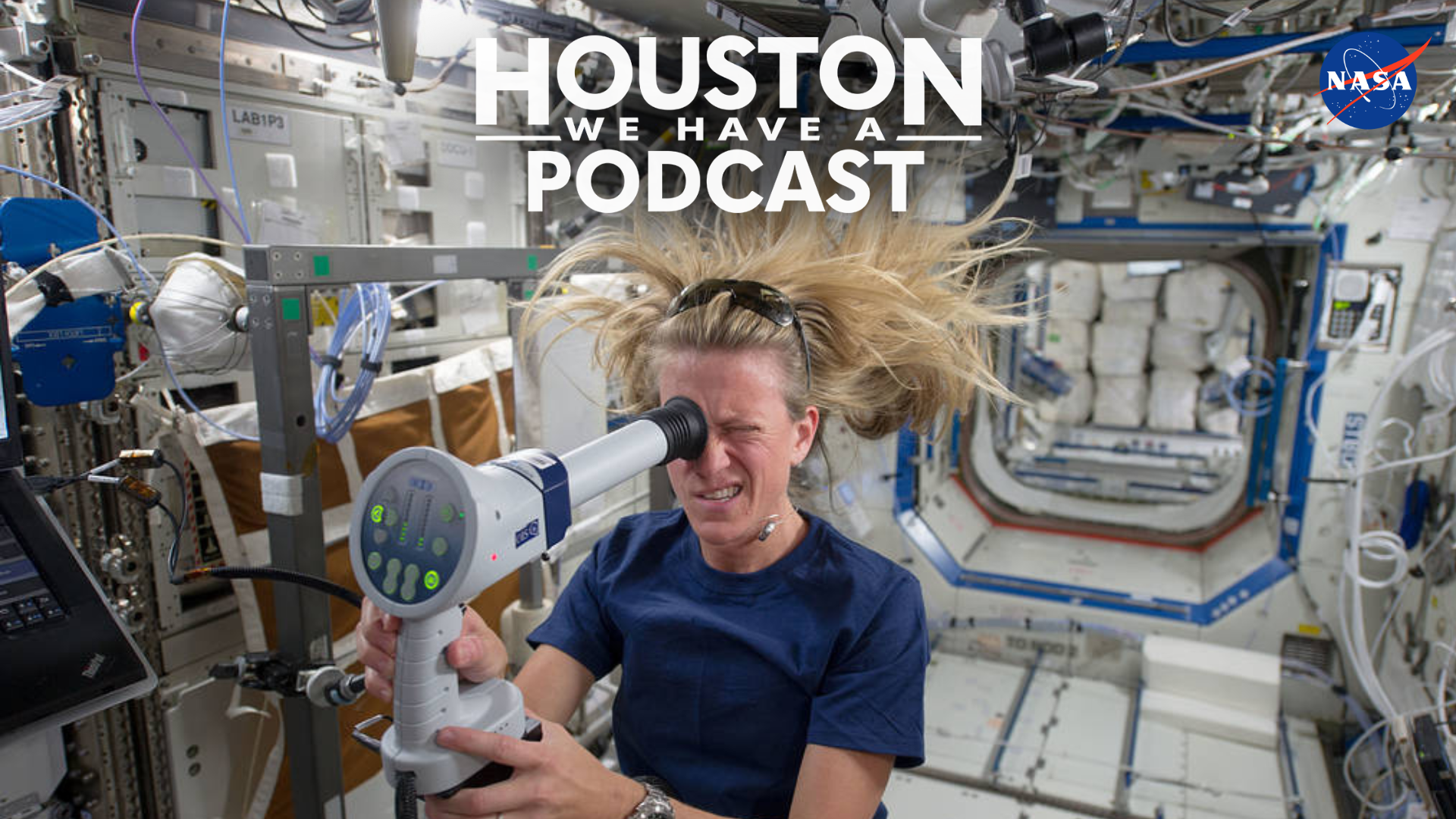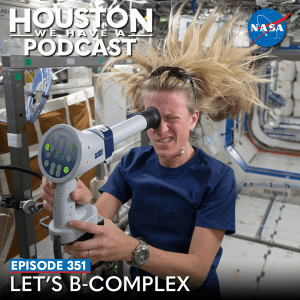
From Earth orbit to the Moon and Mars, explore the world of human spaceflight with NASA each week on the official podcast of the Johnson Space Center in Houston, Texas. Listen to in-depth conversations with the astronauts, scientists and engineers who make it possible.
On episode 351, NASA nutrition scientists discuss how a daily B vitamin supplement might prevent vision changes in astronauts during long-duration space missions. This episode was recorded on June 26, 2024.

Transcript
Host (Leah Cheshier): Houston, we have a podcast! Welcome to the official podcast of the NASA Johnson Space Center, Episode 351, “Let’s B-Complex.” I’m Leah Cheshier and I’m your host today. On this podcast, we bring in the experts, scientists, engineers, and astronauts, all to let you know what’s going on in the world of human spaceflight and more. Spaceflight associated neuro-ocular syndrome, or SANS, affect some astronauts who spend extended periods in microgravity, leading to issues like blurred vision and changes in visual acuity. The common theory for what causes this is that when in space, fluid from the lower half of the body shifts to the upper half, including the head increasing fluid pressure on the eyes. Right now, managing SANS involves monitoring astronauts’ vision and exploring potential preventative measures to mitigate its effects during long-duration space missions. One of those preventative measures might be as simple as taking a B-complex vitamin supplement.
Joining me to talk about SANS and the B-complex study are Scott Smith, nutritionist and manager for Nutritional Biochemistry, and Sara Zwart, senior scientist and deputy manager for Nutritional Biochemistry, both here at Johnson Space Center. Dr. Smith and Zwart are tasked with optimizing nutrition to improve astronaut health and safety on extended duration space missions. They research effects of spaceflight on bone and muscle loss, iron metabolism, and ocular changes in astronauts, and have also contributed to research efforts to understand the role of nutrition in ground-based analog studies like long duration bedrest, undersea missions, and Antarctic winters. Let’s get started.
[Music]
Host: Well, hi, Scott and Sara, and thank you so much for joining us today on Houston We Have a Podcast.
Scott Smith: Thanks for having us.
Sara Zwart: Thank you. It’s very good to be here.
Host: I’m really excited to get into this topic with you. And I want to break down SANS for our listeners, spaceflight associated neuro-ocular syndrome. Can you just break down what exactly that means?
Scott Smith: Well, SANS is a condition that affects astronaut’s eyes, and the name SANS was, they came up with that because they think that describes the general set of symptoms. We’re nutritionists, so we’re not eye experts. And the way I think of it is that it’s changes in astronaut’s eyes that are affected during spaceflight. And there’s some nuance to it. In the simple terms, there are some crew members that went up with perfect vision that came back and needed glasses, but there’s a lot more nuance to it. There are some changes in the back of the eye, what we call the retina. And sometimes people can have changes in their retina that they’re not even aware of, but when the doctors take a picture of the back of their eye, they can see that there’s significant swelling at what we call the optic disc, which is the point where the optic nerve comes into the back of the eye, you can get swelling there and that’s obviously not a good thing. Two of the key things you need to remember anytime you talk about SANS is that as of this minute, we do not know what causes it. There’s a lot of people with theories, but the reality is we don’t know. The other thing is that not everybody gets it.
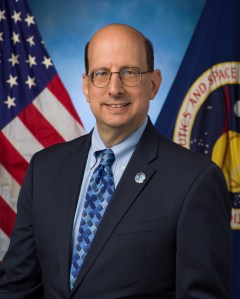
Host: Okay.
Scott Smith: So there’s a lot of thinking early on that this was related to—and there still is thinking that this is all related to fluid shift, that you go into space, the fluid moves up in your head that increases the pressure, pushes on your eye and causes this. Only about 20% of astronauts develop what they call clinically significant SANS. So if it was as simple as you go into space and the fluid goes in your head and pushes on your eye, everybody would get it. And the fact that they don’t leaves open the door for there’s got to be some other factor that affects some individuals that leads them to develop this problem.
Host: Okay. See, I had always thought that this was specifically and directly related to the fluid shift and the fluid pushing on your eyes because it does happen, that happens to every astronaut. Once you launch into space, all that fluid from the lower half of your body kind of just migrates upward. So I thought that that was the number one leading cause of SANS.
Scott Smith: There’s a lot of people that think that.
Host: So when did we first start to notice this issue? When did we start seeing SANS in our astronauts?
Scott Smith: The first cases were noticed around 15 years ago, 2009, 2010 was when they first noticed it in a couple of crew members, and then they started looking in more detail. So yeah, it’s been about 15 years now.
Host: But before that, we’d been doing long-duration missions since about 2001. So do you think it had still been happening up until that point, or you just didn’t notice it until then?
Scott Smith: I think there weren’t enough cases that were significant that led them to look into it. And I think when they started looking more closely and again, looking in detail at the back of the eye, they started to see more things in more people. I think there were early cases or earlier cases that were dismissed as well. You know, people’s eyes changed a little bit, but then they come back, so it’s not a big deal. So I think it was probably there that they just didn’t pick up on it.
Host: Huh. So this is associated with long-duration spaceflight, correct? We’re probably not going to see this for our astronauts on Artemis II, which is maybe 10 days.
Scott Smith: That’s correct. And all through the shuttle flights, they never noticed anything like this. There were some people that talked about again, that there were some transient changes that occurred on shuttle flights, but you came home, and it got better right away. So it wasn’t considered to be a long-term change or a concerning change. It was just sort of a yeah, that’s what happens during spaceflight.
Host: What do you think is the kind of average amount of time that an astronaut has to spend in space before developing SANS? Do you see that as kind of a constant timeframe or is it just different for everybody?
Scott Smith: I don’t think they know yet in detail, but I know when they’ve started, the exams, they do it around 30 days into flight is when they start to notice some changes in some people. So I think 30 days is around the shortest, but they haven’t been able to do eye exams on every day from one to 30 to see that oh, it’s 26.
Host: So we’ve talked about what SANS is, spaceflight associated neuro-ocular syndrome. But what is the astronaut experience? What’s the difference in their vision that they see?
Sara Zwart: From what I understand, it’s up to about one and a half diopter change. Which means they need glasses maybe after they experience SANS. Whereas before they wouldn’t have needed glasses. And some actually can see better after this change happens and some are worse.
Host: And I think I’ve heard before that we send various levels of prescription glasses up with crew members to account for the potential of this happening. Is that right?
Sara Zwart: Yeah, that’s my understanding as well.
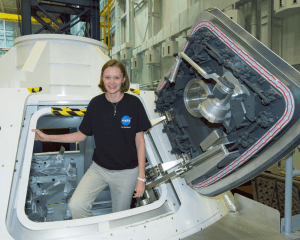
Host: Okay, so we were talking about eye exams on the International Space Station. What’s this look like? I’ll be honest, I’ve been to the eye doctor once in my life, which is probably a horrible thing to admit. But is an eye exam on the space station anything like what we have on Earth?
Scott Smith: Well, we do similar testing. It’s obviously a little bit different than on Earth. The key thing that they do is what’s called OCT, which is ocular coherence tomography, which essentially is taking a picture of the back of your eye. And they use the same instrument that they use at the eye doctor’s office and the way it happens on space station is that one of the crew members will be the subject. They have to put in eyedrops to dilate the pupils. And then you, you sit next to the machine really close and another crew member will work the device that again, takes a picture of the back of your eye. And what happens when they do that is there’s people in Mission Control who are guiding the astronaut on-orbit and watching the screen, seeing exactly what the device is doing on the space station and those images are captured and sent down to the ground and evaluated.
Host: So I guess whenever we determine that someone has SANS, it is a combination of what we see in those scans and also the astronaut’s perception of their vision change?
Scott Smith: That’s correct.
Host: Okay. Because everyone might look like they have it because of the fluid shift, maybe not?
Scott Smith: Yeah, I’m thinking not, and as I mentioned, crew members can be diagnosed with SANS and not know it. So again, you can have changes that when you get that picture of the back of the eye, they can see changes which are concerning to the physicians, but that the crew member is not aware of. It doesn’t affect everybody’s vision. That’s one of the signs. But not everybody gets blurry vision.
Host: Okay.
Scott Smith: So it it’s a very complicated set of characteristics that comprise what we call SANS.
Sara Zwart: Yeah. The only outcome that the crew member would actually notice is the vision change. Like sometimes they could have folds at the back of the eye called choroidal folds. But we’re looking for swelling at the back of the eye, specifically a change in the total retinal thickness. So that’s what that OCT helps us look at.
Host: So does it seem to level off after they’ve been up there for a while, or does their vision continue to seem to get worse?
Scott Smith: That’s a great question and I don’t think we have enough data to really say. In general, we think it levels off that it goes up and reaches a point, it sort of levels off. The couple of people that have flown out to a year don’t seem to get much worse, but that’s really in just a couple of cases. So we don’t know if that’s what everybody will experience or not.
Host: We talked a little bit about this, but when they come back to Earth, do we see their vision snap right back to normal? Does it take a little bit or do they kind of continue to have this condition?
Scott Smith: Some of the signs can get better, but in many cases, they don’t. Again, people that have come back that needed glasses, needed glasses four or five, six years later. So some of the changes appear to be permanent.
Sara Zwart: That swelling tends to get better anywhere from like actually 90 days to six months after flight. So not everybody though, as mentioned, but it seems like most of them do get better about six months after.
Host: Yeah. And I think that kind of makes it a little more clear too, that it’s not necessarily related to swelling or to fluid shift, I should say, because the fluid shifts for astronauts dissipate much more quickly once they get back to, you know, 1G, back to Earth. So I guess you clearly can’t just say it’s due to the fluid shift if that resolves itself once we arrive back on the planet, but it can take a little bit longer to determine if SANS will stick around in the astronaut.
Scott Smith: Indeed.
Host: Hmm. Okay. I read this could be related to a biochemical pathway. It’s called a one-carbon metabolic pathway. That’s at a cellular level. I’m more of a rocket girl than a cell girl. So can you break down what is a one-carbon metabolic pathway? What’s its job?
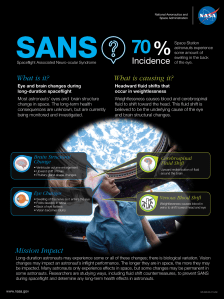
Sara Zwart: So the one-carbon metabolic pathway is a B vitamin-rich pathway. So we’re nutritionists, as Scott mentioned, that that’s what we’re interested in looking at nutrition status and crew members. And so that’s why we’ve started looking at that pathway way back, whenever it was. 2012. So this pathway, its job is to transfer one carbon unit, so single carbon, so a methyl group from one molecule to another. So it’s a really important pathway. It’s got a lot of redundancies because it, because it’s so important in the body, it’s happening in every single cell of the body. It is responsible for a DNA synthesis, inner conversion of amino acids, DNA methylation. So changes after the DNA is made and it makes signaling happen. It’s bottom line. It’s very important. And if like a mother, pregnant woman doesn’t have enough of specific B vitamins in her diet as the baby is forming, then you have outcomes such as neural tube defects and that that’s directly because you’re not getting that DNA synthesis that this pathway is so important for.
Host: Wow. Okay. So that kind of brings us into the topic of B-complex itself. How did you come to this hypothesis that it might be B vitamins that could assist in potentially treating SANS in astronauts?
Sara Zwart: Right. So there’s a kind of a long backstory there. We mentioned, we first started looking at this one carbon pathway because we were interested in their B vitamin status. Well, when this issue first started coming up back in 2009-ish, we started looking at our data. We had pre- and post-flight biochemistry data, both blood and urine. And we found some observations that made us scratch our heads. So we looked at, we found that crew members that were coming home with ocular changes, they had higher levels of certain metabolites in that one carbon pathway compared to those who did not have any ocular changes. And some of those metabolite scan be elevated for various reasons. They can be elevated for if you have a low B vitamin status, they can be elevated if you have genetic differences in your pathway, genetic variants. There’s a lot of different reasons they could be elevated.
Well, we went and did a study at that point, we went and did a genetic study and recruited all of the flown astronauts. And we started looking at a handful of genetics, genes. And we looked at, they were called single nucleotide polymorphisms, or SNPs, in a very select number of genes that we knew can affect these metabolites that we found elevated in crew members with ocular issues. And after that study, we found that crew members that had these specific genetic variants of this pathway, they had more things like optic disc edema, choroidal folds, cotton wool spots. So at that point, we had two pieces of data. We had biochemistry data supporting this pathway might be involved. And then we had genetic data from a very few number of SNPs showing that the genetics of this pathway may be involved.
We then looked at a couple bedrest studies conducted by our colleagues in Germany, and that was the first time they were seeing optic disc edema in bedrest. It’s a six-degree head down tilt model where no pillow was used and they were seeing optic disc edema in some of the subjects. And not all. We looked at our genetics. And the ones that had the most change in total retinal thickness had those same genetic variants that we saw in the astronauts. We saw that in one study, and we saw it in another study. So all this together makes us think that this pathway is likely involved. It’s may not be the factor, but we think SANS is a multifactorial phenomenon. And biological variation, including genetics, may be a contributing factor. So that’s what led us to think about this pathway in relation to SANS.
And we think that B vitamins, you can push that pathway to maximal efficiency by providing B vitamins. So if you have a genetic variation that maybe slows your pathway down, but you give B vitamins, you can push it to its maximal efficiency. So we think a simple countermeasure, such as giving the active form of B vitamins that are required for that pathway, there’s four of them, folate, vitamin B6, B12, and Riboflavin, if we do that, we’re taking genetics out of the equation now. And it’s a multifactorial phenomenon. So, you know, maybe other things, but we’re taking genetics out now and we think this is going to help people that are genetically prone to having SANS.
Host: Wow. This is fascinating. Okay, so number one, what a testament to ground-based studies as well, because you’re able to take what you’ve seen on the space station and then look at what’s happening on the other side of the world in Germany in this bedrest study and compare that, clearly, i’s not just something that happens in space, and pull that genetic component out of it. So you’re kind of testing this on the space station right now and giving astronauts B vitamins. How does this experiment work? Do they take a pill every day, every other day? How does it work to give them these B vitamins and then study what the results are?
Sara Zwart: Right. So yeah, we’re giving up one pill a day. It’s a supplement containing four B vitamins, folate, vitamin B6, B12, and riboflavin. And they start taking it about six months before they fly, and then they’re taking it all the way through their flight and then up to 30 days after. And we’re collecting various measures. We’re taking blood samples, we’re doing eye exams, OCT. We’re doing a vascular function test, and we’re doing that at all the various time points. So about six months before they fly, we’ll do all those measures and then they start taking the supplement. About three months before they fly, we’ll do all those measures again. And then a couple times during flight, including those eye exams and then right as close to landing as possible. And then 30 days after landing just to look at recovery.
Host: Okay. So how many crew members do we have doing this? Is this everyone gets to try it or do we have a control unit?
Sara Zwart: No, well, we have to pitch our experiment to the crew members and you can sign up if you want to. So right now, we’re aiming for 16. We have one crew member that’s completed the entire mission and is back on the ground. So we have one complete, we have two on orbit right now and a couple more. We’ve recruited eight so far just at various stages in their mission.
Host: So how about all of these astronauts who may have been experiencing this? Like, you know, like you said you really started noticing this around 2009, correct? So can they retroactively take B vitamins now and it might help with what they experienced?
Sara Zwart: I’d say if they were going to fly again, yes.
[Laughs]
Scott Smith: But that’s a great question. The answer is we don’t know if somebody who flew and developed SANS, and as we said, the effects seem to be permanent. My suspicion would be if we started giving them vitamins now, that the impact on their eye is likely set. And I don’t know if you could recreate that or reverse that. But really, we don’t know.
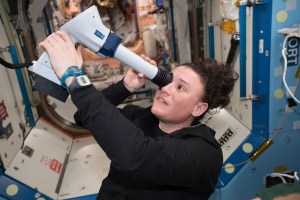
Sara Zwart: But we’re going to find out because we’ve had some crew members that have flown before and are going to be in our study.
Host: Is there anything special about the vitamins that they’re taking or is this something that I can just go buy off the shelf at the local drugstore?
Sara Zwart: So we are especially compounding it through a compounding pharmacy, just so it’s easy to take in one pill. These doses and forms of the vitamin are, yes, you could go out and buy them if you wanted to take four different pills and yeah. So you could.
Host: Well, how long does the study on the space station last? You mentioned that the crew members have to take the pill for six months? Okay. The crew members have to take the pill for six months before they fly, obviously, during their flight, and then for a short time after. How long do you anticipate your study of all of these, you were looking at 16 potential crew members. How long do you think that’ll last?
Sara Zwart: Oh, it’s hard to say. Cause you never know how much interest there will be and how quickly they’ll sign up. But we’re halfway there and we just, I feel like we just started, so I give it at least three or four more years until we’re completely done and have data.
Host: Okay.
Sara Zwart: Flight studies take a while.
Scott Smith: Indeed. Flight studies take a while and the astronauts are presented with a set of experiments and they’re allowed to pick and choose which ones they want to do. And at the moment, there’s another big study that if they want to do that one, they can’t do ours. Or conversely, if they want to do ours, they can’t do the other one just because of the amount of time required in each of them. So it’s not that not everybody wants to do our study, it’s that they need to pick and choose amongst the ones that are available.
Host: That’s so interesting. I didn’t really realize that the astronauts get a choice in what studies they’ll participate in. I mean, I know that they do a lot of research on the space station with their own hands and their bodies are research experiments as well. But are all of those other experiments related to your office, or are they just different?
Scott Smith: They span the work that’s done by the Human Research Program. So the other big one that’s up there now is called CIPHER, which is actually a group of, I think around 15 different experiments looking at bone health and cardiovascular health and all sorts of things. So they can be all over the map.
Host: I’ve heard of that one too.
Sara Zwart: A crew member can’t do them all together just because there’s time limits and blood volume limits, so we don’t want to bleed them dry.
Host: Yeah. You only have so much, right? Only so much to give. Okay. Wow, that’s so fascinating. I didn’t realize they had that choice. I love learning that. So thinking beyond the space station, this is really a testbed for us, for going to the Moon, going to Mars. How does this help us prepare for long-duration missions? You know, where we might live in lunar orbit for a while, Gateway, or we might go to Mars and it takes really long time just to even get there, right?
Sara Zwart: Yeah. So there’s definitely risks of all sorts as we go further than low Earth orbit. SANS is definitely one of the top risks and the human research side, and I see this as we are testing a countermeasure, a very low risk countermeasure. And if this helps, and this is going to be a low-cost solution for minimizing risk for SANS, that will allow us to go off to the Moon and Mars.
Host: Yeah. It is truly a very low-cost. I mean, and it’s low weight too because it’s just vitamins. It’s not like it’s any equipment that has to be flown up, or hardware I should say. It’s using what’s already on board the space station when it comes to examining astronaut’s eyes and then flying up the vitamins. That’s fascinating.

Scott Smith: And one of the ways to look at this is we are dabbling in what many people to be considered personal nutrition, personalized nutrition or personalized medicine, where by looking at individual’s genetics, you can treat them differently. Either, you know, there’s a field called pharmacogenomics where you look at somebody’s genetics and know which medications to give because they respond differently to certain medications than others. And this is the same thing that what we are trying to do is to establish that people with a certain genetic profile are at risk of developing SANS. And you could give them these supplements to mitigate that problem, but you wouldn’t necessarily have to give them to everybody because not everybody’s going to be at risk because they don’t have the genetics. So it’s dabbling in that field out there that people are kicking around on Earth of could we look at different dietary differences in individuals to try to help them be healthier throughout the course of their lives.
Host: Yeah, that’s amazing. It’s furthering the study of that entire field on Earth as well. So talking a little bit more about Earth, let’s bring it home How does the research into SANS and into the use of a B-complex vitamin affect, you know, how could that benefit our life here?
Scott Smith: I always feel that all human research that we do in spaceflight has some implications for people on Earth, whether it’s bone studies and help us understand how bone changes during flight or cardiovascular changes or eye changes. There’s always knowledge that we gain in that unique environment with this population that informs people treating individuals on Earth. With regard to this work, one of the things we think is happening is that, again, your genetics affect the function of this pathway, and we think it’s affecting the function of this pathway inside of the cells that line your blood vessels. And that by giving these vitamins, it will make your blood vessels work better. And Sara mentioned that we’re testing vascular function as one of the parts of the study. And when you think about that, these vitamins have impact on vascular function and again, the knowledge from our studies will help inform cardiovascular research here on Earth.
One of the populations that we’ve looked at, because they seem to be very similar to astronauts that develop SANS, is women with polycystic ovary syndrome. And we’re actually doing a study in women with polycystic ovary syndrome, where we’re looking at their genetics and their one carbon biochemistry to see if women with PCOS might be what I would call the analog population for SANS. Or to say that another way, hypothetically, if we were to fly women with PCOS in space, they would all develop SANS. And we can’t prove that yet. But we’re studying that with a group of physicians of the Mayo Clinic to try to nail that down because the women with polycystic ovary syndrome have, again, biochemical and endocrine changes that are similar to what we see in astronauts. And again, the knowledge that we gain from this study might help in the treatment of the 10 to 20% of women on Earth that develop PCOS.
Host: That’s incredible. I mean, that is a very widespread condition. And so the fact that NASA research into how we can benefit our astronauts can translate to helping, like you said, 10 to 20% of women on earth, that’s a huge benefit.
Scott Smith: As Sara said, we’ve been studying this for a little over 13 years now, and we’ve talked to anybody who will listen about this. And we’ve had a hard time over the years convincing people that there’s something there. And as the data continued to compile, we reached critical mass to start this flight study. There was a case on space station a few years ago where a crew member developed what was considered to be the most significant case of SANS that they’ve seen to date. And at the time, the flight surgeons came to us and said, “Well, you guys have talked about vitamins in SANS, which vitamins would you send?” And we told them what we were thinking, and lo and behold they went off and bought those vitamins and flew them on a cargo vehicle and gave them to that crew member. And when we look back at the data, almost simultaneously with them taking those vitamins, you can see the edema in the back of the eye start to lessen.
Host: Wow.
Scott Smith: It’s a case study. There are few side issues. But we were pretty excited when we first saw those data.
Host: Yeah. The correlation was there.
Scott Smith: Exactly. And we just published the case report of that study and that vitamin use in JAMA Ophthalmology in the July issue.
Host: Wow.
Scott Smith: It’s a very challenging topic. And I think that’s part of the reason why we’ve had trouble getting the word out on this over the years, because every time we talked about this, it was like, yeah, that’s too hard.
Host: No, it’s not.
Scott Smith: Between the biochemistry and the genetics and the SANS and it’s very challenging.
Host: So I guess my next question is, if we look at how a vitamin complex can benefit this condition, are there any other things that your office is looking at that we might see something similar? I mean, I guess astronauts don’t come back with many other permanent conditions like that.
Scott Smith: Not that I’m aware of at the moment. But we we’re always looking for… one of the great things about nutrition as a field is that it intertwines with almost every system in your body. So while we focus primarily on nutrition, we’ve done work over the years, again, looking at the relationship of nutrition with bone health or with cardiovascular health. Now with ocular health, we’ve found differences in chemistry related to blood clot formation in astronauts that have developed blood clots onboard space station. And again, have helped to try to explain why that happens. So what else is going on? What’s next? I don’t know, but we’ll see.
Host: So I’m wondering, obviously there are a lot of natural sources of these vitamins as well. Folate, that’s in a lot of leafy greens, right? So if you could somehow increase the amount of those substances that astronauts are getting on the space station, does that help mitigate some of this as well? Or do you think they still need something like a B vitamin?
Sara Zwart: Yeah, I mean the level we’re providing right now, you could not get in your diet. The way we saw this, we have one shot. We’ve got to make sure the doses we’re giving are known on in ground studies to affect vascular function. So that those are the levels we chose. Could we get by with less? Possibly. And maybe we can tweak that in the future depending on how this study goes. But as far as food sources, I mean, it’s always a great idea to eat plenty of fruits and vegetables and that’s where you’re going to get all these B vitamins that would help everybody beyond the eyes. It’s going to help your immune system, your bones, your cardiovascular system. As Scott mentioned, every single system in your body is affected by nutrition.
Scott Smith: When we first started looking at our data, what was striking is that we saw differences in the biochemistry, the blood biochemistry, of affected astronauts. That is, we saw higher concentrations of chemicals suggesting that the one carbon pathway was not functioning as well in those individuals. And what was really striking is that we saw those differences before flight and that was one of the things that led us to go down the path of that it might be genetic and that that might be affecting their pathway. That this was not something that was induced during spaceflight.
Host: Right. That makes sense because that’s clear. You can’t have the fluid shift yet.
Scott Smith: Right.
Host: Well, where can people learn more about this? Anyone who’s interested?
Sara Zwart: Well, every bit of research we’ve ever done, we publish. So they can definitely look up all of our papers. We’ve got a book that we wrote on several different levels. One aimed more for a graduate level, I guess, and then one aimed at like fifth and sixth grade. So you can see those on the Human Research Program website.
Host: And we will all be eagerly awaiting for this study, this current ongoing study, on the space station to be complete in a few years and see what data you get back then. Maybe we come back and hash it all out and find out what we learned.
Sara Zwart: That sounds great. We’ll be Happy to come back.
Host: Well, thank you again for joining us today. That is all the time that we have. And looking forward to everything that’s next.
[Music]
Host: Thanks for sticking around and I hope you learned something new today. If you want to know what else is up with NASA, you can visit us online at nasa.gov for the latest. You can also continue your audio journey at nasa.gov/podcasts. And if you want to learn more about CIPHER, check out Episodes 196 and 290 of Houston We Have a Podcast. You can reach out to us here at Johnson Space Center on social media. That’s Facebook, X, or Instagram, and use #AskNASA on your favorite platform to submit your idea. Make sure to mention it’s for Houston We Have a Podcast. This episode was recorded on June 26, 2024. Thanks to Will Flato, Dane Turner, Abby Graf, Jaden Jennings, and Gary Jordan. And of course, thanks again to Scott and Sara for taking the time to come on the show. Give us a rating and feedback on whatever platform you’re listening to us on and tell us what you think of our podcast. We’ll be back next week.
This is an Official NASA Podcast.



























